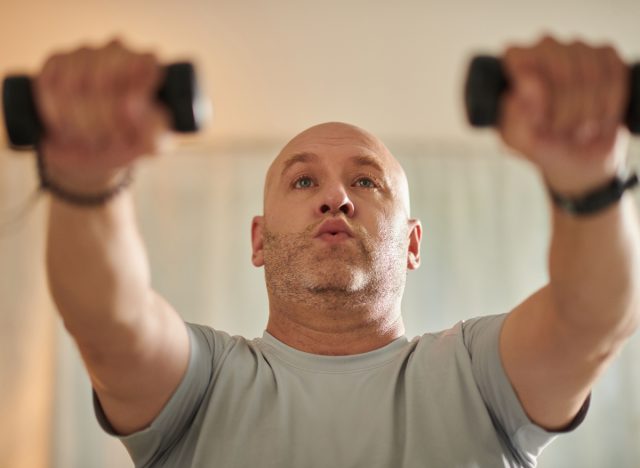I'm a Trainer & Give These Fitness Tips to All Male Clients Over 50

As a fitness trainer with years of experience, I've had the privilege of working with male clients across a wide spectrum of ages and fitness levels. Each stage of life brings unique challenges, but for men in their 50s, these challenges shift significantly. This is what prompted me to compile my top fitness tips for men over 50 to live by.
While younger clients often focus on building muscle mass, improving athletic performance, or achieving a certain physique, the goals for men over 50 tend to prioritize long-term health, functional strength, and injury prevention. This phase of life demands a more tailored, mindful approach to exercise, as the body no longer responds to training like it once did.
For men over 50, maintaining an active lifestyle becomes more about preserving the physical capabilities they've developed over the years. It's not just about lifting heavier weights or running faster but about sustaining mobility, avoiding injury, and ensuring that fitness routines are manageable for the long term.
Strength naturally declines with age, flexibility decreases, and cardiovascular endurance may begin to wane. As such, focusing on maintaining muscle mass, joint health, and cardiovascular fitness becomes crucial to staying strong, agile, and independent. The key is to train smarter, not harder, while keeping an eye on form, recovery, and overall health.
In addition to adjusting the intensity of their workouts, men in their 50s also need to embrace a more strategic and holistic view of fitness. It's no longer just about the hours spent at the gym—it's about integrating practices that promote joint mobility, improve balance, and protect cardiovascular health. Flexibility and mobility become as important as strength training, and recovery techniques like stretching, foam rolling, and proper rest are non-negotiable.
By focusing on these areas and maintaining a balanced, sustainable approach, men can continue to stay fit, strong, and injury-free as they age. Below are the 10 most effective fitness tips I give to all my male clients over 50 to help them achieve these goals.
Prioritize strength training.

Strength naturally declines with age, so preserving muscle mass becomes essential. Strength training helps maintain muscle mass, improves metabolism, and promotes joint health.
Aim to perform strength exercises for all major muscle groups at least two to three times per week. Incorporate compound movements such as squats, deadlifts, and presses, which target multiple muscles simultaneously and enhance functional strength for daily activities.
Incorporate mobility work.

Mobility is often overlooked but is critical for men over 50. As you age, your joints lose their natural range of motion, leading to stiffness and injuries.
Dynamic stretches and mobility exercises help maintain flexibility and prevent joint problems. To keep your joints fluid and pain-free, regularly perform exercises like hip openers, thoracic spine rotations, and ankle mobility drills.
Don't skip cardio.

Cardiovascular health becomes increasingly important as you age. Include moderate-intensity cardio, such as brisk walking, cycling, or swimming, for at least 150 minutes per week. You can also add shorter, high-intensity interval training (HIIT) sessions to improve cardiovascular efficiency and boost metabolism.
Focus on core strength.

A strong core supports posture, balance, and stability, which are crucial as we age. It also helps prevent lower back pain, a common issue for men over 50.
Incorporate exercises like planks, bird dogs, and dead bugs into your routine to engage your core muscles and build functional strength that translates to daily activities.
Stay consistent, but listen to your body.

Consistency is key, but so is listening to your body. Overdoing it or ignoring signs of fatigue or pain can lead to long-term injuries.
Rest and recovery are just as important as exercise itself, so balance your workouts with adequate recovery time. Focus on working smarter, not harder, to stay injury-free.
Use proper form and technique.

As your body changes, improper form can easily lead to injuries, particularly in weightlifting. Focus on maintaining proper form, whether you're lifting weights or performing bodyweight exercises. If necessary, work with a trainer or physical therapist to ensure you're performing exercises correctly and safely.
Add balance training.

Balance declines with age, leading to an increased risk of falls. Include balance exercises in your routine to improve coordination and stability. Simple movements like standing on one leg, heel-to-toe walking, or using balance boards can go a long way in keeping you steady and confident in everyday movements.
Stretch regularly.

Flexibility decreases with age, and tight muscles can lead to discomfort or injury. Incorporate stretching after each workout to keep muscles limber and promote faster recovery. Focus on major muscle groups, particularly the hamstrings, hip flexors, and shoulders, which tend to become tight over time.
Monitor your heart rate.

As you age, monitoring your heart rate during exercise becomes essential. Keeping your heart rate within a healthy range ensures you're working efficiently without overstraining. Consider investing in a heart rate monitor to track your exertion during workouts and adjust the intensity as needed.
Embrace recovery techniques.

Recovery is vital to maintaining longevity in your fitness routine. Utilize recovery techniques such as foam rolling, massage, and yoga to aid in muscle repair and reduce soreness. Prioritizing recovery can enhance performance and help avoid burnout, ensuring you stay consistent in the long term.









